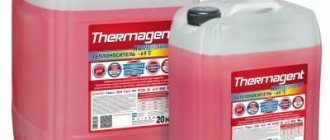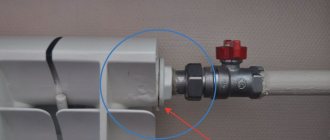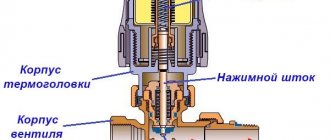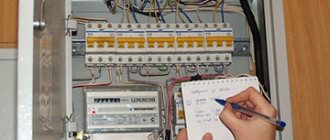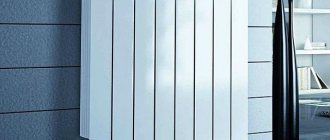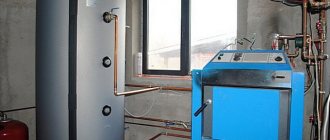Home » Uncategorized » Determining the volume of the heating radiator
The coolant in the heating system is not only tap water, which is pumped inside due to its pressure. For example, in country villages, water is often poured into the heating system in buckets, taken from a well or a nearby reservoir. Or even use non-freezing liquids. The second option is used infrequently only because of the high cost of the material, but those who plan to live in a dacha or country cottage only on weekends and holidays use antifreeze liquids so as not to drain the coolant from the heating system each time. Therefore, calculating the volume of coolant is an important indicator, which includes the volume of the heating radiator, the volume of pipes and the heating boiler.
The boiler capacity is indicated in the product passport. This indicator will mainly depend on the power of the unit and its size. The volume of pipes can be determined from special tables:
| Diameter (mm) | Volume of one linear meter (l) |
| 15 | 0,177 |
| 20 | 0,31 |
| 25 | 0,49 |
| 32 | 0,8 |
| 40 | 1,25 |
| 50 | 1,96 |
To determine the total volume of the required coolant, which will fit only in the pipes, it is necessary to measure their total length and multiply by the indicator from the table. If you are using a project to build a heating system, then all the necessary calculations and measurements can be carried out using it.
Below we will consider popular methods for calculating the volume of a heating radiator.
Methods for calculating volume
The size of the internal space of batteries manufactured in accordance with GOST can be determined in two ways:
- Look at the technical documentation and find the desired number among the specified characteristics. Next, you need to carry out simple mathematical operations.
- Pour in water and measure its volume or weight.
Determining the volume using documentation
Initial numbers can be taken both from documentation with technical characteristics and from special tables compiled by manufacturers. In both cases, a certain indicator is indicated, which corresponds to the volume of water that can fit in a linear meter of radiator.
This specific indicator is the center distance. It refers to the distance that separates the upper and lower collectors. Many manufacturers produce batteries observing standard center distance values. Most often it is 30 and 50 cm.
Calculating the volume of water that can fit in a heating device manufactured in accordance with GOST involves the following steps:
- Determining the length of panel radiators or the number of sections of aluminum or bimetallic batteries with smooth internal walls (such walls can reduce hydraulic resistance).
- Determination of the volume of water per linear meter. To do this, in the table they look at such a characteristic as the interaxle distance. Opposite its value, they look for the volume of water. If the heating device is sectional, then find out how much water can fit inside one section.
- Multiplying the obtained values.
This method is quite difficult to use for tubular radiators and batteries made according to individual needs. This is because for the first devices, manufacturers use various GOST-tested pipes. They have different diameters, wall thicknesses, and lengths. Therefore, there are no tables with average values of volume and distance between collectors. They are impossible to compose. Of course, documentation with technical characteristics, as well as a table compiled by the manufacturer, can come to the rescue. In addition to the center distance, it can also indicate the resistance of the heated liquid and the weight of the device with this liquid.
As for a heating device manufactured at the request of the client, there may not be technical documentation for it with very detailed characteristics. After all, it is produced only in a small batch, and there is no point in calculating all the characteristics, including volume and water resistance.
Average volume values
For example, radiators with a center distance of 500 mm are taken. So the volume is:
- 1.7 liters for each section of the ChM-140 cast iron radiator designed for high pressure;
- 1 liter for each section of the same battery, however, a new model;
- 0.25 l for every 10 cm of panel device type 11. For structures with two and three panels designed for low pressure, this figure is 0.5 and 0.75 l per 10 cm;
- 0.45 liters for each lightweight aluminum battery section.
- 0.25 l per section of a bimetallic radiator manufactured in accordance with GOST.
Universal method
It is suitable for any type of heating device with any center distance. To implement it, you need to stock up on a large amount of water and a container, the volume of which is known.
The measurement is carried out as follows:
- Install plugs on the two lower holes. It would be possible to install a third plug on one of the top holes, but it is better to wait. This is because when you pour water into one hole, air must escape through the other.
- Pour water until it begins to flow out of the second free hole.
- Place a plug on this hole and slowly add water until the entire battery is completely filled. During pouring, count the number of containers poured. This can also be done while draining water from the radiator. True, you will have to drain the water into a bucket or something else and then pour it out.
- Multiplying the number of containers poured by their volume. The final figure is the volume released according to GOST rules of the battery.
Selecting a heating battery based on the area of the apartment How to choose heating radiators based on heat transfer indicator How hot the heating batteries should be Soldering holes and cracks in an aluminum radiator
Water volumes for various heating system elements
Water volume (liters) in the radiator section
| Radiator material/type | Dimensions*: height×width, mm | Volume, l |
| Aluminum | 600×80 | 0,450 |
| Bimetal | 600×80 | 0,250 |
| Modern cast iron battery (flat) | 580×75 | 1,000 |
| Old style cast iron battery () | 600×110 | 1,700 |
*IMPORTANT! The dimensions in the table are approximate.
In most models of modern manufacturers, they are ±20 mm in width; the height of heating radiators can vary from 200 to 1000 mm.
The volume of radiators with very different heights can be approximately calculated from this table using the rule of proportion: it is necessary to divide the volume by the height and then multiply by the height of the selected model. If the heating system is extended, then it is better to check the volume parameters with the manufacturer.
Volume of water in 1 linear meter of pipe
- ø15 (G ½") - 0.177 liters
- ø20 (G ¾") - 0.310 liters
- ø25 (G 1.0″) – 0.490 liters
- ø32 (G 1¼") - 0.800 liters
- ø40 (G 1½") - 1,250 liters
- ø50 (G 2.0″) – 1,960 liters
Also read the review of which pipes are best to choose.
The main dimensions of the internal diameters of pipes (a range of values from 14 to 54 mm are taken) that the consumer may encounter.
| Inner diameter, mm | Volume of liquid in 1 m of pipe running, l | Inner diameter, mm | Volume of liquid in 1 m of pipe running, l |
| 14 | 0,1539 | 30 | 0,7069 |
| 15 | 0,1767 | 32 | 0,8042 |
| 16 | 0,2011 | 34 | 0,9079 |
| 17 | 0,2270 | 36 | 1,0179 |
| 18 | 0,2545 | 38 | 1,1341 |
| 19 | 0,2835 | 40 | 1,2566 |
| 20 | 0,3142 | 42 | 1,3854 |
| 21 | 0,3464 | 44 | 1,5205 |
| 22 | 0,3801 | 46 | 1,6619 |
| 23 | 0,4155 | 48 | 1,8096 |
| 24 | 0,4524 | 50 | 1,9635 |
| 26 | 0,5309 | 52 | 2,1237 |
| 28 | 0,6158 | 54 | 2,2902 |
Modern models of heating radiators
The weight of 1 section is 3.8 kg. water holds 0.8 liters, so the weight of one radiator section with water will be 4.6 kg. With a heat flux of 140 W, to heat a room of 20 m2, 14 sections will be required, and the weight will be 64.4 kg with water. Thus, this figure differs by 40% less than that of the classic MS 140 sample. If this value is divided into two parts (32 kg each), we can conclude that installation on walls made of modern materials, including porous concrete, It is quite possible to carry out without additional fasteners.
An even lighter design was developed by Russian manufacturers. Their heating devices are offered under the EXEMET brand. The MODERN model has the following weight characteristics:
One section from this manufacturer weighs 3.2 kg, heat output is 93 W. To heat a room of 20 m2 you will need 22 sections, then the total weight will be 70.4 kg. These parameters are not bad, especially considering that the company produces models with possible installation on the floor.
The EXEMET FIDELIA model weighs 12 kg, heat dissipation is 156 W, the total mass of the device for our example is simply monstrous - 154 kg. The complex issue of installation is irrelevant here, since the first and last sections are equipped with legs for placing the device on the floor.
So, in order to ensure uninterrupted service for the heating system, you cannot ignore such important indicators as the weight and volume of the battery section. Thanks to the correct calculation of the load on the fastening elements, you can count on reliable installation and long-term operation of the device.
Formulas for calculating the volume of liquid in heating
The total volume of liquid will consist of the amount of coolant in the boiler, pipelines and batteries. The volume of the expansion tank is not taken into account here, because water will flow into this device only in critical cases when temperature and pressure increase.
To calculate the amount of liquid in a pipe, the following formula is used: V=S*L, where
S is the internal cross-sectional area of the pipe;
L – pipeline length.
Information regarding the cross-sectional area of the pipe taken from the tables may differ from the actual dimensions (material used, features of the production of plumbing products). That is why the diameter is measured with a caliper, after which the cross-sectional area is calculated. It is better to entrust such calculations to specialists, since heating systems are quite extensive and branched structures.
Why know the volume of coolant in the battery?
Calculation of the volume of coolant in the battery is done in order to:
- choose the correct radiator mount. It must withstand not only the weight of the product, but also the weight of the water that fills the entire internal space. The weight of the liquid is equal to the volume;
- select a boiler of the required power. If it is weak, it will create little pressure and the water will move slowly;
- select an expansion tank of the required volume. Many people refuse this element. However, it is better to use it, since it compensates for the pressure created by the increased volume of the heated coolant. For example, when heated, the volume of a liquid increases by 4%. If it has nowhere to go, then the pressure on the batteries and pipes increases. Sooner or later, thermal expansion will cause a leak;
- determine the total coolant requirement. To do this, you need to take into account the internal volume of pipes with low hydraulic resistance, as well as the volume of the heating boiler capable of creating the required pressure;
- maintain the correct concentration of antifreeze. This applies to cases where water will be mixed with antifreeze. This can be done, and in some cases the resulting liquid for heating radiators freezes at lower temperatures than 100% antifreeze;
- select the type of circulation. The coolant can move naturally (from top to bottom) or move under pressure created by the pump. The natural type of circulation is chosen in the case of batteries with a large internal volume and low resistance to the heated liquid. As for the second type, the size and weight of the batteries does not matter.
Expansion tank calculation
Basic Rules:
- The volume of the expansion tank must be at least 10% of the volume of the heating system. This volume will be sufficient to expand the coolant when heated within 45...80 °C.
- For large extended systems with high coolant temperatures, the volume reserve should be at least 80% of the volume of the heating system. This is relevant for boilers with a maximum coolant temperature above 80...90 °C, and steam heating systems from furnaces.
- The volume of the expansion tank with a safety valve can be 3-5% of the volume of the heating system. But at the same time, it is important to control its operation: when the valve operates, it is necessary to replenish the system with water.
- When calculating, it is necessary to take into account the pressure in the system. In most cases, for one and two-story cottages it is 1.5...2 atmospheres. The weight of the finished tanks is calculated for these indicators with a margin. When designing a large-volume heating system with increased pressure characteristics in communications (for high-rise buildings), it is necessary to take this parameter into account.
- It is imperative to take into account the type of coolant when choosing. The lighter the fluid in the system, the larger the expansion tank it requires.
Comparison : Which boiler to choose for heating your home? Advantages and disadvantages.
Aluminum radiator section power
Many people note that in the formula for calculating the number of sections, you can substitute the power of the heating radiator section that the manufacturer indicated in the technical documentation. This idea is correct when a coolant with a temperature of 100 °C circulates in the heating system and is cooled to 80 °C. The fact is that manufacturers indicate the heat transfer of the battery under the condition ΔT = 70 °C. They calculated this indicator based on the formula:
- where t1 represents the inlet coolant temperature,
- t2 is the coolant outlet temperature,
- t3 represents the room temperature of the house.
ΔT = 70 °C only when the coolant has the above temperature levels and t3 = 20 °C.
After that, they take a special plate in which the manufacturer indicated the heat transfer of the radiator at different ΔT, and look for the resulting indicator. Next to it is a correction factor. For example, for ΔT = 50 ° C it is 0.65. This figure is multiplied by the power of the radiator section. Next, the obtained result can be substituted into the formula indicated at the very beginning.
Types of heating batteries
Standard
These units are available in a range of heights, typically from 300mm to 750mm, with the largest range of lengths and height configurations ranging from 450mm to 600mm high. Lengths vary from 200mm to 3m or more, with the largest range being 450mm to 2m in length.
Panels and convectors
Such radiators usually consist of one or two panels, but sometimes 3-panel ones are found. Modern single panel radiators have a corrugated panel forming a series of fins (called "convectors") attached to the rear (wall-facing) side of the panel, which increases the convection power of the battery. They are commonly known as "single convector" (SC). Radiators consisting of two panels with fins stacked on top of each other (with fins in the middle) are known as "dual convector" (DC). There are also double radiators, consisting of one finned panel and one without fins. Older design radiators consisted of one or two panels without any convection fins.
A traditional standard radiator has seams on the top, sides and bottom of each panel (where the pressed sheets of steel are joined together). Nowadays, most seamed batteries are sold with decorative panels installed on the top and sides (the top ones have vents for air circulation) and are known as "compact" batteries. An alternative to the top seam radiator design uses a single sheet of pressed steel and this sheet is joined in a "roll" fashion at the top of the radiator.
Low surface temperature batteries
Most of these radiators are designed so that their radiating surfaces have relatively low temperatures at normal heating system temperatures. They are used where there may be a risk of burns - most often in children's institutions, nursing homes, hospitals and hospitals.
Designer batteries
There is a huge selection of radiator designs available that can be more pleasing to the eye than their conventional counterparts. Some designer radiators are available in tall, narrow configurations which may be suitable for rooms with, for example, narrow walls near doors where conventional radiators cannot provide sufficient power with limited wall space available.
Skirting radiators
These devices are usually disguised as baseboards. The operation of these radiators is similar to the effect of a “warm floor”, since the user’s eye does not notice any radiator sections on the walls. Installing skirting boards allows you to save interior space.
Heated towel rails
Such radiators are specially designed for drying towels, as well as for drying bathtubs and showers. However, the thermal output of heated towel rails is significantly reduced when covered with towels, and even if they are not covered with towels, heated towel rails are able to dissipate much less heat than conventional radiators of similar size. Heated towel rails are usually not enough to heat rooms. They are used only in relatively small and well-insulated bathrooms. Some heated towel rail designs contain a regular radiator with towel racks above and sometimes on the sides of the radiator. Such devices have better thermal power.
Parameters of aluminum radiators
The technical characteristics of heating batteries are the first thing a consumer pays attention to before purchasing. The most important indicators of a truly high-quality product are:
- The level of heat transfer of one section, since it depends on:
- First, how many elements are needed to heat one room.
- Secondly, how warm the room will be thanks to the radiator.
- Thirdly, what will the microclimate in the room be like?
- Resistance to water hammer and operating pressure of an aluminum radiator.
- Cost of the finished product.
The volume of one section of an aluminum radiator indicates its power and largely depends on how it was manufactured.
If the aluminum battery was made by pressing, then its parts were connected using glue, which makes it vulnerable. Such a radiator is not afraid of corrosion, but increased pressure can damage it.
The capacity of one section of an aluminum radiator, regardless of the method by which it was produced, is almost the same, but the fact that the cast model is stronger and more durable, heats up faster and can be adjusted in size puts them in first place in sales.
Find out useful information about aluminum batteries on our website:
How to correctly compare bimetallic radiators with each other?
Anyone who carefully approaches the choice of heating batteries for their home or apartment strives to purchase products with optimal performance and technical characteristics. To correctly select the most suitable radiator, the models being compared must be of the same size. In the reference data, the parameters are given for one section, so you need to compare not the devices as a whole, but their structural parts. The main parameter by which the division into standard sizes occurs is the interaxle distance.
Radiators with different center distances.
The center distance is the size between the axis of the upper and lower collector. Like all-aluminum models, bimetallic heating radiators are mainly produced with a center distance from 200 to 800 mm. Models with a large center distance, and as a consequence, with an increased section height (but a smaller width of the entire radiator), are rare. They are used if the interior features of the room do not allow placing a horizontally located device.
The device of a bimetallic radiator.
Geometric parameters
The main geometric characteristics of a bimetallic radiator are its height, as well as the width and depth of the section. The height, as a rule, is 60 - 80 mm higher than its center distance.
Most manufacturers produce models with a section width of 80 mm. Knowing the number of sections, you can easily determine the total width of the device.
The depth of the section is 80 – 100 mm. The radiator can be either constant depth or varying in height, like the stylish and elegant DreamLiner series device from Royal Thermo.
Thermal power
This parameter allows you to determine how many radiator sections of a particular model are needed to heat a room of a certain area. Thermal power is measured in Watts and is at an interaxial distance:
- 500 mm – from 170 to 200 W;
- 350 mm – from 120 to 140 W;
- 300 mm – from 100 to 145 W;
- 200 mm – about 100 W.
In their information and technical materials (instructions, manuals, catalogs), manufacturers indicate tables showing the number of sections optimal for heating rooms of various sizes.
The steel core is the basis of the structure.
Volume (capacity) of one section
In bimetallic radiators, coolant circulates through steel cores. The core is an H-shaped welded structure consisting of an upper and lower collector connected to each other by a vertical tube (heat pipe). Each manifold has two side holes with internal threads, thanks to which the sections can be connected using steel nipples. This design completely eliminates contact of the coolant with aluminum.
Unlike aluminum radiators, where the heat pipe has an oval cross-section, the steel cores of bimetallic models use exclusively round tubes, which provides for a smaller capacity of each section. Thus, the bimetallic Rifar Base 500 has a section capacity of 0.20 liters, while the aluminum Rifar Alum 500 model of the same size has a volume of 0.27 liters.
Section of the device in section.
Section weight
Bimetallic radiators have more mass than similar models of aluminum radiators. This is explained by the use of steel cores in their design, the density of which (and therefore the mass) exceeds that of aluminum. For example, the bimetallic radiator Varmega Bimega 500/80 weighs 1.75 kg, and the aluminum radiator Almega 500/80 from the same manufacturer weighs 1.2 kg.
Pressure
The operating pressure of bimetallic radiators is 16 – 40 atm (1.6 – 4.0 MPa). According to regulatory documents, devices must be tested by pressure testing the heating system with a pressure 1.5 times higher than the operating value. The documentation also indicates the value of the maximum pressure, upon reaching which it can begin to collapse.
Types of coolants
As a rule, the question of what coolant is used in a centralized heating system is not asked, since water always flows through the heating pipe there. Another thing is autonomous heating, where you can choose the best option for a particular house, taking into account the climate of the region where it is built.
- Antifreeze for heating systems has been used for heating country houses for many years and has proven itself to be excellent. Its best qualities (the ability not to freeze at temperatures down to -70 degrees) are especially good in buildings where there is no permanent residence of people. Summer residents can close their house, come several times a month to warm it up, and not worry that something will happen to their heating system.
- Alcohol-containing coolants have properties similar to antifreeze, only they can not freeze at -30 degrees. Their use is not advisable in residential buildings, since such liquids contain ethyl alcohol, which is not only highly flammable, but also dangerous to humans.
- Water in autonomous heating systems is only good where aluminum radiators are under supervision, that is, people permanently live in an apartment or private house. It has one indicator that aluminum does not “like” - the ability to cause corrosion in metals. If the carrier is drained from the system in the summer, then by the beginning of the new season the batteries may leak due to corrosion that has “eaten” the metal. Residents should leave coolant in the system to prevent this from happening.
The viscosity of all three coolants is different, and when manufacturers indicate the volume of an aluminum radiator, they imply that it will contain water. When purchasing such a device for a heating system, for example, one that uses antifreeze, you should compare its characteristics with the capacity of the battery.
Summarizing
The principle is better to underfill than the opposite; it is not applicable in heating systems, since airing the system will mean cold radiators. By calculating the volume of each structural element of the heating system using tables or empirically, heat consumption will become more meaningful and enjoyable. And repairing or replacing a separate fragment will no longer be a sealed secret.
The video in this article shows the process of pouring coolant into the heating system.
Did you like the article? Subscribe to our Yandex.Zen channel
Section volume and coolant flow
Today, not all autonomous heating systems are filled with water. This is due to two factors.
- A situation arises when the owners need to leave the house without heating for a long time, since due to a long absence there is no need to heat the premises.
- Water tends to freeze even at zero temperatures. When water freezes, it expands and turns into ice, that is, it changes from one physical state to another. During this process, the intermolecular bonds of water are released and changed, resulting in a huge force that breaks radiators and pipes made of any metal.
To prevent such situations from occurring, instead of water, another coolant is used to fill the heating system, which does not have the problem of freezing. These can be household antifreezes such as:
- ethylene glycol;
- saline solution;
- glycerin composition;
- food alcohol;
- petroleum oil.
Thanks to special additives that are introduced into these components, coolant compositions retain their state of aggregation in liquid form even at subzero temperatures.
Storage and wear processes
In order to reduce the risk of deterioration of battery performance during long-term storage, you must adhere to the following rules:
- do not allow complete discharge;
- storage temperature is not lower than -20 °C and not higher than +30 °C;
- charge annually for 48 hours;
- The battery surface must be clean to avoid self-discharge.
The main processes that destroy a lead-acid battery:
- Sulfation is the formation of crystals of lead salts. They are deposited on the plates and prevent the normal passage of current.
- Corrosion is an oxidative process that destroys the lead electrodes of a battery.
- Shedding - the active mass in the cells of the positive electrodes loses normal adhesion to the base and falls off.
- Adhesion defects also lead to the sliding of the powdery contents of the conductive plates.
Failed batteries cannot be repaired and must be recycled. Vapors of heavy metals can cause serious harm to humans and the environment, so artisanal smelting of lead from batteries is life-threatening.
Device Features
In many respects, steel is suitable as a material for the manufacture of heating batteries. It is durable, fairly light and has high thermal conductivity.
Panel radiators made from this material are produced from its highest grades by stamping. During this process, channels are applied to the steel sheet through which coolant will flow in the finished product. As a rule, they are divided into horizontal upper and lower channels, and numerous vertical ones (3 for every 10 cm).
The stamped elements are subsequently joined in pairs using roller welding, thus forming a closed panel within which the coolant flows when connected to the heating system.
The power depends on the number of panels and the presence or absence of convectors in finished products, which can be determined by their markings.
What materials are batteries made from?
Radiators not only help create a pleasant temperature in the room, but can also become a real decoration of the room. They differ radically from each other in the material of manufacture.
The following options are in great demand on the heating equipment market:
Aluminum appliances are lightweight and have a modern appearance. A characteristic feature is the efficiency of energy resources spent on heating and the ease of installation work. Thanks to the thin walls of the batteries, quick heating and a high level of heat transfer are achieved.
Bimetallic radiators are models made from steel and aluminum. A successful combination of metals ensures rapid heating and increases the ability to withstand pressure loads. This type of radiator is suitable for both autonomous and central heating systems.
Cast iron equipment is characterized by a high degree of heat transfer, reliability and durability. These are unassuming contours, like those of the old MC-140 models, well known from Soviet times. They also produce more respectable models with modernized and modified surfaces, smoothed inside and out.
Copper batteries are durable, but have a fairly high price. Therefore they are used quite rarely.
Steel heat exchangers are characterized by a simple design, which helps ensure convection heating of the room.
To get to know steel radiators in more detail, you need to understand their classification by type, familiarize yourself with the technical characteristics, features of installation work and operation.
Heater Rado
Panel heaters from this German company are the best option for cost-quality ratio.
Steel radiator type 22, 500x1000 mm Rado, has a power of 1826 W when the media is heated to +110 degrees and a permissible pressure of up to 9 Bar (test 14).
This is truly a panel radiator of the highest quality, as it is made from environmentally friendly steel produced in Europe.
The steel heating radiator type 22 (500x1000) has a low weight with high heat transfer and two convectors, which allows you to heat the room in a short time, saving energy costs.
Steel panel radiator type 22: technical characteristics
Today, manufacturers of panel heating structures offer the following types of models:
- No. 10 has only one panel and lacks a convector and cladding.
- Type 11 has one panel and one heat exchanger.
- The steel radiator type 22 is in greatest demand among the population. Its characteristics indicate that it has two panels and two convectors. This is a more harmonious combination, since the product is obtained with high heat transfer, affordable price and low weight.
- Type 33 radiators are equipped with three heat exchangers attached to three panels. This is the most powerful and expensive type of steel panel radiators.
To quickly navigate the marking of steel products, you should remember that the first number in the number indicates the number of panels, and the second – convectors.
Panel radiator type 22 is considered the optimal choice for the following parameters:
- Their power varies from 576 W to 4115 W. This run-up is directly related to the height and length of the panels.
- The steel radiator type 22 can withstand operating pressure from 6 to 10 at a test pressure of 12 atmospheres. Although heating structures made of steel are quite strong, they are best used in closed autonomous systems. If you need to connect to a centralized heating system, you need to calculate the power of the panels in advance and purchase a device taking it into account.
This disadvantage can be compensated if the thermal output of steel radiators type 22 is controlled by a pressure reducer.
Even if you take the smallest size of steel radiators of this type, you can see how different their power ratings are. For example, with a height of 300 mm and a length of 400 mm, it will be 576 W, while for a product of the same length, but with a height of 500 mm, it will be 823 W.
Steel radiator 22 type 500x1000 mm has a power of 2057 W. These indicators are not the same for different manufacturers.

